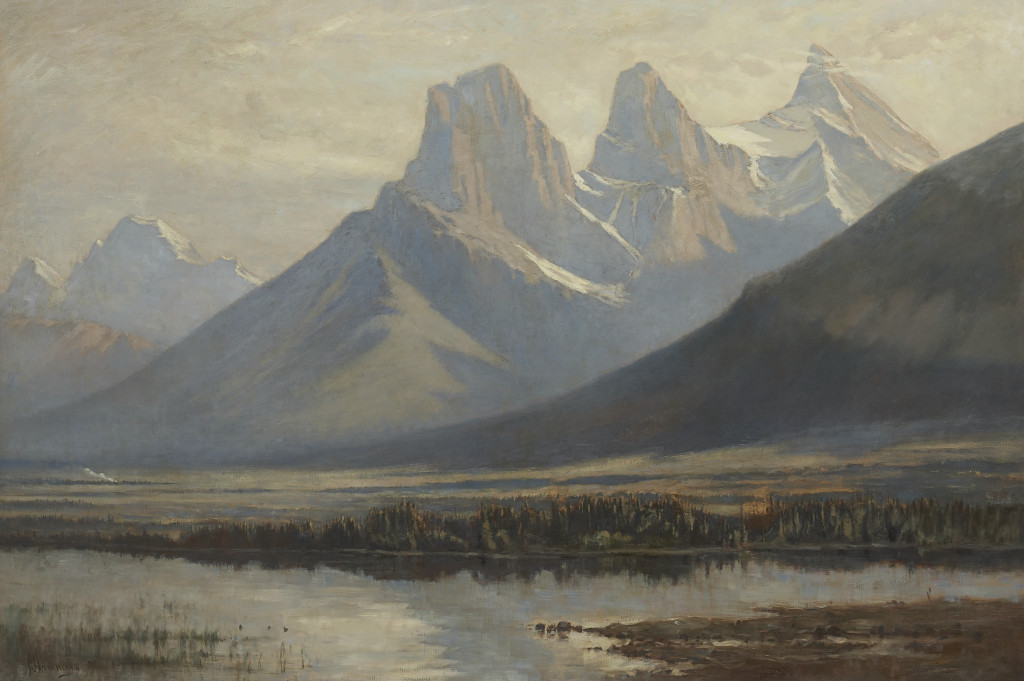John Hammond’s The Three Sisters is one of the largest and most ambitious nineteenth-century paintings in Glenbow’s collection. Read on to learn more about Hammond’s work in the Rocky Mountains and his connection to the Canadian Pacific Railway.
The summer of 1892 was a difficult time to be painting in the Rockies. It was very rainy, and although some artists were occasionally willing to paint under umbrellas, cloud cover made it hard to see the mountains. The mosquitoes were intense, making painting outdoors unpleasant no matter what the weather was like.[1] Even in the best conditions, the mountains represented a challenge: many artists struggled to convey the sheer scale and drama of the Rockies, especially when they were making small drawings or painted sketches. But for John Hammond (1843–1939), this summer was an extraordinary opportunity and a turning point in his career.
In the early 1890s, Hammond was a well-established artist based in Saint John, New Brunswick. He had been elected an Associate of the Royal Canadian Academy of Arts, the country’s most prestigious artistic organization, in 1890, and he regularly submitted his work to national exhibitions. He was known to specialize in landscape painting, and he was particularly interested in light and atmospheric effects. For the Canadian Pacific Railway, he was an ideal candidate for an important project.
After the completion of the railway in 1885, the company’s General Manager, William Van Horne, supported artists in travelling to the Rockies because he believed paintings of the mountains were an opportunity to raise awareness of the region’s extraordinary beauty — and hopefully to inspire tourists to visit. In 1892, he wanted something special. He commissioned two artists, Hammond and Montréal painter William Brymner (1855–1925), to go “to the Rockies for the purpose of painting several large pictures of the beautiful mountain scenery,” because “It is the intention of the company to send these pictures to the art exhibition of the World’s Fair, where they will, besides being good testimony of the progress of art in Canada, give hundreds of thousands of visitors to the fair an idea of the wonderful scenery to be found in the Canadian Rockies.”[2]
Hammond would have had a good idea of what to expect. He had been to the Rockies before: as a young man he joined the Transcontinental Survey in 1870, assisting with the expedition’s photography. As well, he worked with Notman Photographers, a business that had its own commissions for representing the mountains. Perhaps most importantly, he knew Van Horne; the two men met around 1890 when Van Horne visited Hammond’s studio in New Brunswick, where Van Horne had a summer residence.[3] Hammond undoubtedly understood precisely what Van Horne was hoping to accomplish at the World’s Fair in Chicago in 1893.

During their journey, Hammond and Brymner undertook to make sketches of a huge range of sites in the mountains. Among the sites they visited were Banff, Mount Rundle, Castle Mountain, Cathedral Mountain, Mount Stephen, Mount Lefroy, Mount Baker, Mount Sir Donald, Lake Louise, Lake Agnes, the Illecillewaet Glacier, Nelson, Yale, several places along the Bow and Fraser rivers, and, of course, the Three Sisters. After returning home, both artists created several paintings for the company. Working in their studios with the sketches (and sometimes photographs) they made in the summer, they developed enormous compositions. Yet even the opportunity to paint on a grand scale wasn’t enough for the Rockies’ vast heights: in many paintings, the peaks stretch to nearly the very top of the canvas, as if they are too big for the canvas to contain. Notwithstanding this challenge, the company was pleased with Hammond’s and Brymner’s work. At the World’s Fair, the artists showed their paintings as part of the Canadian art display and as part of a special display of paintings in an exhibit about the Canadian Pacific Railway in the Transportation building — Hammond’s The Three Sisters was featured there.[4]
Following the Chicago exhibition, the Canadian Pacific Railway remained an important patron for Hammond. The company arranged to reproduce his work, offered him further commissions, and supported him in travelling to China and Japan in 1900. By that time the company had a steamship line, and a Canadian artist’s representations of destinations in Asia had the potential to become invaluable promotion. The trip was a success, and Hammond continued to undertake work for the company in the early 1900s, visiting the Rockies again in 1901 and 1902 and thereafter completing paintings developed out of sketches from his earlier travels. The culmination of his work was a commission to create six murals for the company’s offices in London, England, in 1906. This project was effectively a conclusion: though Hammond remained friends with Van Horne, the London murals were his last major commission. His artistic career continued, but with a more personal focus on landscapes near his home in New Brunswick.
References
[1] Roger Boulet, Vistas: Artists on the Canadian Pacific Railway (Calgary: Glenbow, 2009), 156–57.
[2] “An Important Commission,” The Gazette, Montreal, May 30, 1892.
[3] Dodie Perkin, “A Pictured Life: A Biography of John Hammond, R.C.A., 1843–1939” (BA Thesis, Mount Allison University, 2023), 55.
[4] Lynda Jessup, “Canadian Artists, Railways, the State and ‘The Business of Becoming a Nation’” (PhD Thesis, University of Toronto, 1992), 237.
